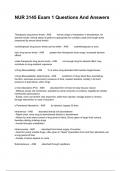Exam (elaborations)
NUR 3145 Exam 1 Questions And Answers
- Course
- NUR 3145
- Institution
- Florida State University
Therapeutic drug serum levels - ANS narrow range of medication in bloodstream, for desired results; clinical status of patient is appropriate for condition; peak and trough levels (measured by serum blood levels) nontherapeutic drug serum levels can be either: - ANS undertherapeu...
[Show more]



